
Haz clic aquí para leer la versión español
3 Ahaw 18 Pax (February 22, 2022)
William H. Mex:
Online Introduction to Classic Maya Hieroglyphic Writing


Haz clic aquí para leer la versión español
3 Ahaw 18 Pax (February 22, 2022)
William H. Mex:
Online Introduction to Classic Maya Hieroglyphic Writing

Haz clic aquí para leer la versión español
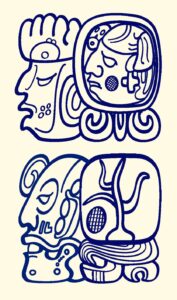
We at MAM wish you all a happy Gregorian New Year! I hope you all had a safe holiday with family and friends.
Continue reading
Haz clic aquí para leer la versión español
The Thanksgiving holiday has arrived in the United States, and we want to wish everyone a safe and restful celebration with family and friends, as we give thanks to all of our resilient Maya colleagues for the excellent work they continue to do on behalf of their languages and cultures, amidst all of the many challenges they have faced—not the least of which continues to be the ongoing pandemic.
This month, as we await the reports from our recently funded online workshops, we again harken back to 2019 with a report from Omar Chan, who worked with the YAs. As we await reports from the several online workshops we have recently funded, we have another report from one of the last in-person workshops from 2019. This is now the last report we have from before the pandemic that we have received, but we wanted to be sure to share with you the good work of Avenamar Gómez López with the Tojol-ab’al students from Las Margaritas, Chiapas, Mexico, who are actively engaged in preserving their language through the inspiration of ancient Maya writing—Ojer Maya Ts’ib. In doing so, they have had to adapt the Classic Maya syllabary to their own language, which includes the phoneme /r/, which did not exist in the Classic script. Like many contemporary Maya speakers, they have chosen to modify some of the Classic syllabic glyphs to accommodate the phonemes in their languages.
We hope you enjoy this month’s report, and we give thanks to all of you who kindly support our ongoing work and the work of many Maya teachers and students. It is our profound hope that we may all finally and safely reunite next year for the next Congreso.
Tzachatal
Sincerely,
Michael Grofe, President
MAM

Haz clic aquí para leer la versión español
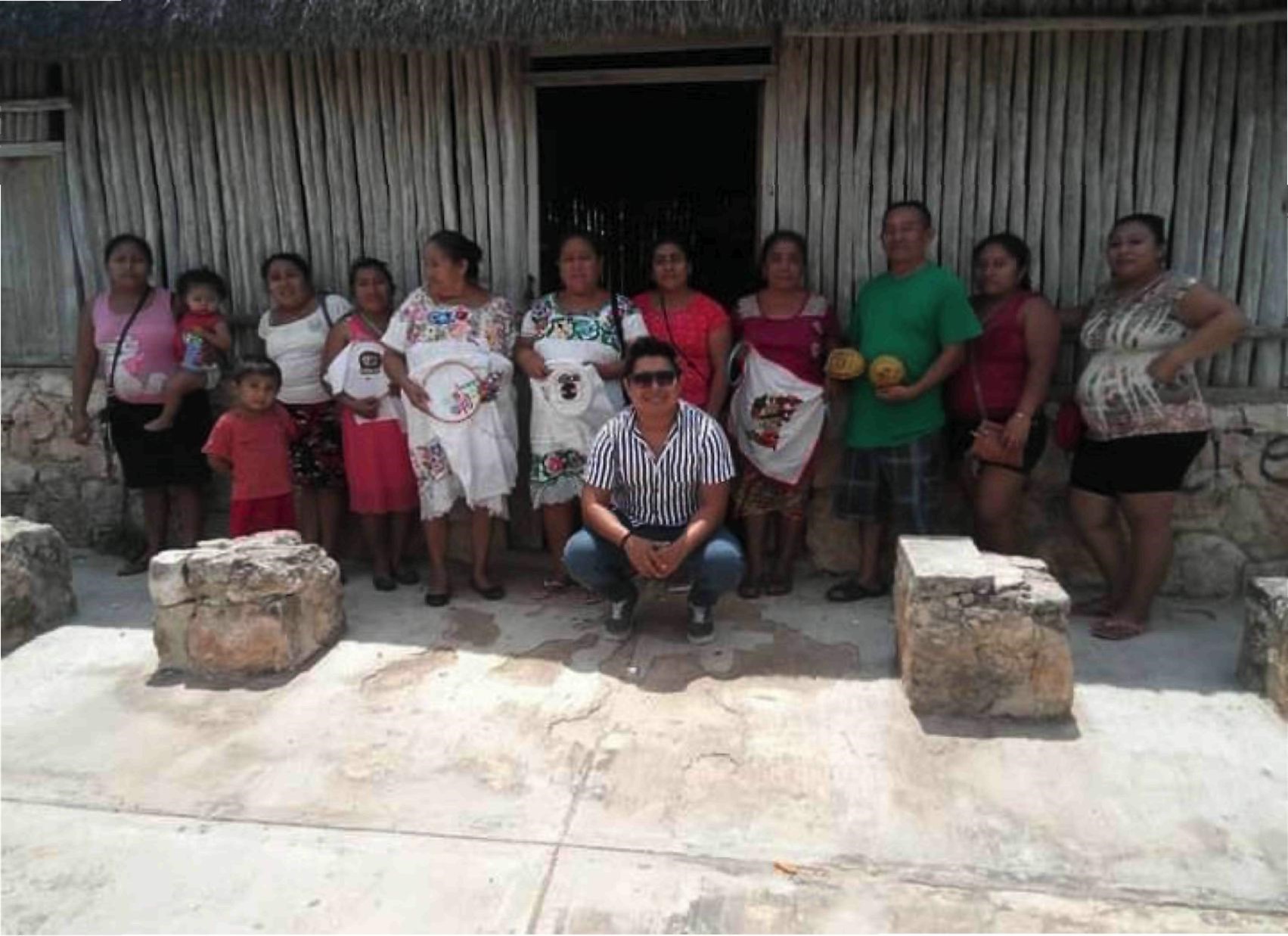
The autumn has arrived and the harvest season is upon us. It is a time to remember and honor our ancestors, and all of those we have recently lost. We send our warmest regards to all of our friends as we move into the cooler months ahead, hoping that all of our families will finally have a chance to gather together and share a home cooked meal. We look forward to the New Year, with hope and promise that we will all overcome this pandemic and once again meet in person to continue our meaningful work together.
This month, as we await the reports from our recently funded online workshops, we again harken back to 2019 with a report from Omar Chan, who worked with the Yüumtsilo’ob K’aaxo’ob Cooperative in Huay Max, Quintana Roo, where he conducted a workshop sponsored by MAM in which members learned to embroider and inscribe glyphs onto cultural products like huipiles and gourd cups. Omar is currently facilitating one of our first online workshops this month, and we look forward to reporting back about that soon!
We would also like to congratulate our friend and colleague Martín Gómez Ramírez on his upcoming publication, Escrito Está Sobre Oxchujk: El verdadero significado de oxchujk en glifos de la cultura maya. Back in September of 2019, we published Martín’s report from a conference he facilitated at the Intercultural University (UNICH) in Oxchuc, Chiapas in which he presented a dedicatory hieroglyphic plaque that he had written and sculpted in Tseltal. Based on a parallel reading in the Paris Codex, Martín proposes that the original meaning of Oxchujk refers to ‘Three Captives’. Here, we include one of Martín’s many illustrations.
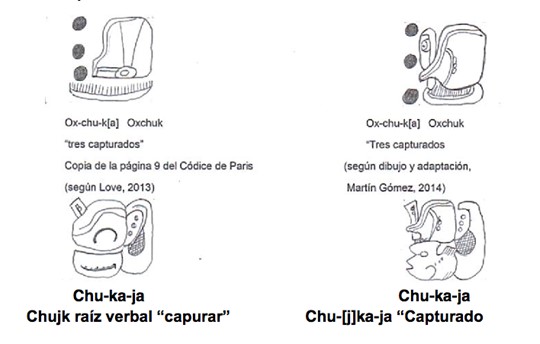
Also included in the publication are additional name glyphs that Martín has designed for multiple municipalities in Chiapas. We wish Martín all the best with his new book, and we wish you all a safe and healthy autumn.
Yum Bo’otik
Wakolowal ta a pisilik
Sincerely,
Michael Grofe, President
MAM
Continue reading
Haz clic aquí para leer la versión español
Congratulations to Our First 2021 Online Mini-grant Recipients!
This month, we are pleased to announce our first round of mini-grant recipients for teaching online! Congratulations to the following applicants:
Augusto Tul Rax
Online course for 25 Poqomchi’ teens.
Chitul Santa Cruz Verapaz, Alta Verapaz, Guatemala.
Gloria Nayeli Tun Tuz
Online workshop for 20 Yucatec students.
Chichimilá, Yucatán, México.
José Alfredo Hau Caamal and Erika Evangelina Puc Ay
Online course for 10 Yucatec university students.
Chichimilá, Yucatán, México..
Omar Alejandro Chan May
Online course for 15 Yucatec students, ages 12+.
Felipe Carillo Puerto, Quintana Roo, Mexico.
Pedro Alejandro Vásquez Tay
Online course for 20 Uspanteko students, age 15-20.
Uspantán, El Quiché, Guatemala.
We look forward to hearing about these exciting online courses and publishing their reports and recorded lectures in the near future! We encourage more applicants to contact us if they are interested in teaching online or offering recorded content to make publicly available, particularly content for specific Maya language communities that can potentially reach a wider audience during these isolating times.
This month, we also hear back from one of our new mini-grant recipients about her last workshop from 2019. Gloria Nayeli Tun Tuz shows us the marvelous, inscribed jícara bowls (hollowed out gourd halves) that her students have made.
Continue reading
Haz clic aquí para leer la versión español
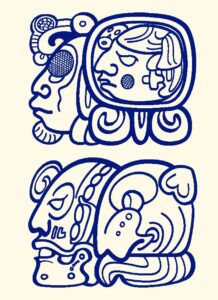
11 Ajaw 18 Xul: Drawing by Jorge Pérez de Lara
Presenting a copy of the Dresden Codex at the Ch’okwoj Maaya Tz’iib workshop
We are happy to report that we are currently receiving, reviewing, and granting our first round of mini-grants for online education! We have sent applications to all of those who have participated in our survey, and if you are a Maya teacher interested in receiving an application, please be sure to submit your information with our MAM Online Education Survey for Maya Facilitators:
https://www.surveymonkey.com/r/5WM6JS6
These surveys help us to assess the needs of the applicants, and to determine how to best help our Maya colleagues, and there is an option to both teach a live online class, and/or to record either public or private educational videos to post on our website.
Recently, we received a notification from our friend José Alfredo Hau Caamal about the last workshop that he carried out with Gregorio Hau Caamal in early 2020 for young students in the Ch’okwoj Maaya Tz’íib group in Xocén, Yucatán, just prior to the pandemic. It was sponsored by the Xocén Birding Trail, which helped to produce a wonderful video in which we see the students receiving instruction about Maya writing in their native Yucatec language. I will include a link to the video below, as well as the communication from the group. It is a hopeful example of the kinds of online content we hope to soon publish on this website in the near future, particularly at a time when face-to-face instruction is still so challenging.
Next month, we will be announcing our first round of recipients of our latest mini-grants, so please stay tuned!
Yum Bo’otik.
Sincerely,
Michael Grofe, President
MAM
Good Evening,
José Alfredo Hau Caamal, participant of a group called Ch’okwoj Maaya Ts’íib, held his last workshop of 2020 in person in the beautiful town of Xocen municipality of Valladolid Yucatán, with the support of the Xocén Birding Trail (a group of young people who promote bird watching).
What is relevant about the workshop?
When we got together we decided that it is very important to participate in the transmission of what we have learned in the four previous Congresos in which we have been participants, so Gregorio Hau and his assistant created a small workshop in the Yucatecan Mayan language where we expose our ancient Mayan writing.
It is with great emotion that we share with you this workshop published in the following link with the aim of showing you that we are constantly taking advantage of each of the workshops taken in the attended Congresos, from the first Congreso in Valladolid, Yucatán, Mexico to the last in Huehuetenango, Guatemala.
This year we intend to continue holding workshops in the communities as little as possible since this pandemic has locked us up but not tied us down, so we are looking for alternatives to continue.
The Ch’okwoj Maaya Ts’íib group sends you a hug and congratulations on your great work at MAM.
www.youtube.com/watch?v=IXxPhCbZAbU
versión español


11 Ajaw 18 Xul: Drawing by Jorge Pérez de Lara
Presentación de una copia del Códice de Dresde en el taller de Ch’okwoj Maaya Tz’iib
¡Nos complace informar que actualmente estamos recibiendo, revisando y otorgando nuestra primera ronda de mini-becas para educación en línea! Hemos enviado solicitudes a todos los que participaron en nuestra encuesta, y si usted es una maestra o maestro maya y se interesa en recibir una solicitud, asegúrese de enviar su información con la Encuesta sobre Educación en Línea de MAM para facilitadores mayas:
https://www.surveymonkey.com/r/5QPZ2ZB
Estas encuestas nos ayudan a evaluar las necesidades de los solicitantes y a determinar cómo ayudar mejor a nuestros colegas mayas, y existe la opción de impartir una clase en línea en vivo y/o grabar videos educativos públicos o privados para publicar en nuestra página web.
Recientemente, recibimos una notificación de nuestro amigo José Alfredo Hau Caamal sobre el último taller que realizó con Gregorio Hau Caamal a principios de 2020 para jóvenes estudiantes del grupo Ch’okwoj Maaya’ Tz’íib en Xocén, Yucatán, justo antes de la pandemia. Fue patrocinado por Xocén Birding Trail, que ayudó a producir un video maravilloso en el que vemos a los estudiantes recibiendo instrucción sobre la escritura maya en su idioma nativo yucateco. Incluyo aquí un enlace al video, así como la información de contacto del grupo. Es un ejemplo esperanzador del tipo de contenido en línea que esperamos publicar pronto en este sitio web en el futuro próximo, particularmente en un momento en que la instrucción presencial sigue presentando un desafío.
El próximo mes, anunciaremos nuestra primera ronda de beneficiarios de nuestras últimas mini-becas, así que ¡hay que mantenerse atentos!
Yum Bo’otik.
Atentamente,
Michael Grofe, Presidente
MAM
Ch’okwoj Maaya Tz’íib: Nuestro último trabajo para 2020
Buenas Noches,
José Alfredo Hau Caamal, participante de un grupo de nombre Ch’okwoj Maaya Ts’íib, realizó su último taller del 2020 de manera presencial en el bello pueblo de Xocen, municipio de Valladolid, Yucatán, con apoyo del Xocen Birding Trail (un grupo de jóvenes que promueven el avistamiento de aves).
¿Que tiene de relevante el taller?
Al reunirnos, decidimos que es muy importante participar en la transmisión de lo aprendido en los cuatro congresos anteriores en la cual hemos sido partícipes, por lo que Gregorio Hau y su servidor creamos un pequeño taller en lengua maya yucateca, en el que exponemos nuestra escritura maya antigua.
Con gran emoción, les compartimos este taller, publicado en la siguiente liga, con el afán de demostrarles que estamos en constante aprovechamiento de cada uno de los talleres tomados en los congresos asistidos, desde el primer congreso en Valladolid, Yucatán, México, hasta el último en Huehuetenango, Guatemala.
Este año pretendemos continuar realizando talleres en las comunidades, apenas y sea posible, puesto que esta pandemia nos ha encerrado mas no atado, por lo que estamos buscando alternativas para continuar.
El grupo de Ch’okwoj Maaya Ts’íib les envía un abrazo y felicitaciones por su gran labor en MAM.
www.youtube.com/watch?v=IXxPhCbZAbU
Continue readingHaz clic aquí para leer la versión español

Thank you to all of our supporters who replied to our survey! In the past month, MAM has also received responses to the survey we sent out to our Maya colleagues regarding online education. There were fewer responses than we had anticipated, and this tells us that other priorities are still likely pressing as the pandemic continues throughout much of the world, and in all of the nations where our Maya colleagues reside. However, I would like to share some of the responses we received, and to summarize what we are learning thus far that has helped to shape our plans to inaugurate a long-awaited, online mini-grant program beginning this summer.
For those Maya colleagues who would still like to respond to our survey, we would love to hear from you! You may do so at the following link, as it helps us to assess the various needs and possibilities for online learning. Please note that this survey is intended for our Maya friends who have either facilitated workshops in the past, or those who would be interested in teaching online or producing online educational videos about the Maya script that we could post on our website:
https://www.surveymonkey.com/r/5WM6JS6
From the responses we gathered, nearly all Maya facilitators reported that they have regular online access, but 50% replied that their students and community members do not have regular internet access. 70% have had experience teaching online through either Zoom or Google Meet. 90% of our respondents replied that they would be willing to teach MAM-sponsored workshops online, while 80% are interested in recording educational videos to post on our website.
While there is a great interest in teaching online or recording educational videos, 70% of those who replied stated that they would require training, which tells us that we need to focus some of our efforts in this regard. While there are various needs in each community, many have asked for unlimited time on Zoom, which would enable them to more easily facilitate both synchronous classes or to record asynchronous educational videos. In some cases, there are needs for computer equipment, programs, and published resources. Given the lack of reliable internet in many Maya communities, it may make more sense to begin by funding projects to record and posting online educational videos where synchronous classes may not be possible.
60% of those who responded were from various states in Mexico, 30% were from Guatemala, and 10% were from Belize. Here are some of the responses regarding the various challenges different Maya communities have been facing during the pandemic in several different countries:
“My community, like other Mayan communities, has been suffering from the total abandonment of the central government concerning the health of the communities. It is a bit difficult to focus only my community, as the problem is throughout the country of Guatemala, all of which is suffering. The problem where the pandemic has us is now complicated above all in the communities where there are still not vaccines for everyone.”
“In advance we appreciate your concern and interest, we find ourselves very well, just as our community has been isolated from the city to avoid contagions, our children receive every month of the visit of their teachers to exchange tasks.”
“Yaxunah is a community where all people are supported. It is a strong community that knows how to get ahead little by little. There were suspected cases of the Covid-19, but they ended up being a common cold. We are well in Yaxunah—nothing more than a natural disaster has hit us, but we knew we had to get ahead of it.”
“In the Mayan communities of Quintana Roo, many cultural and educational activities have been paused in person, and many of the courses, workshops or reports have been presented through different digital platforms and with the help of social networks. Thanks to platforms such as Zoom and Meet, we have been able to establish bond links with our students, where the Ts’iib’ system has also been present as a reference of the artistic and cultural legacy of our community, as well as the use of the Cholqij, calendar, It has been presented as a guide for the understanding of the cycle of the days and have been shared on timely occasions to understand the rains and the lunar phases.”
“Thank you very much for giving the survey, but I consider that there are many things to clarify that MAM should know or understand, and it is only to remind you here that many Maya communities or indigenous peoples do not even have a school. Maya children and youth have to walk many hours to get to their school, and our goal is to bring the workshops to them and to those forgotten communities.”
“In my community we have had several cases of COVID19 and a few deaths. I had my students learning prehispanic music, which had to be halted because we could not get together to practice. Therefore, I involved them in backyard gardening. With the help of the ministry of agriculture, each child had a piece of land tilled and receives seedlings of cucumber, radish, habanero peppers, sweet peppers, jalapeno peppers, tomatoes, cabbage, pumpkin and cilantro. A few weeks ago we had a thanksgiving Mayan ceremony where the children participated. They said their prayers in Maya T’aan. Now, I am thinking of involving them in arts such as embroidery and weaving.”
We send our heartfelt wishes for healing and resilience to our Maya friends, and we encourage all Maya facilitators who wish to engage in online teaching to complete our survey. We hope to be able to help in whatever way possible to keep hope alive, and to continue our work of bringing literacy in the Maya Tz’iib’ to continuing generations of Maya people as we launch our online mini-grant program in the coming month. We are strategizing about the best ways to roll out our new mini-grant program to suit the needs of each applicant.
Here is wishing all of us a summer of hope, healing, learning, and love!
Maltyox, Yum Bo’otik.
Sincerely,
Michael Grofe, President
MAM
Haz clic aquí para leer la versión español

Dear Friends of MAM,
This past year has forced educators all over the world to transition to online platforms, and one of the silver linings of this pandemic has been the blossoming of various technologies that have allowed us to remain connected.
Because the ongoing pandemic continues to prevent our Maya colleagues to gather safely in classrooms and workshops, we are inaugurating new ways for Maya teachers to reach out to their students, both through online classes, as well as through uploading recorded lecture videos online.
MAM is currently surveying our Maya colleagues to see what their needs may be regarding online access, teaching experience, and training, and we are proposing to make our MAM website at discovermam.org a repository for both public and private online educational videos made by Maya teachers for their students.
There is a great need for educational videos about Maya writing and the calendar in Spanish, as well as in different Mayan languages, and we would like to support the creation of more content like this.
This month, we also have a short survey that we are asking you, our supporters and friends, to take, either above or at this link on SurveyMonkey: https://www.surveymonkey.com/r/5XLGNQS
This survey is to see what kind of content you would like to see on our MAM website. Traditionally, we post reports from on the ground, face-to-face workshops in the field every 40 days, but this has not been possible for many months. We would like to hear from you about what kind of content you would like to see in the future.
We wish you all a safe and healthy return to life beyond the pandemic, hoping that the wide distribution of vaccinations reaches far and wide to finally bring us out of this crisis.
Thanks very much for participating in our survey!
We look forward to hearing from you, and we hope we can find ways to keep us connected, while also keeping us all safe.
Sincerely,
Michael Grofe, President
MAM
versión español

Queridos amigos de MAM,
El año pasado ha obligado a los educadores de todo el mundo a realizar la transición a las plataformas en línea, y uno de los aspectos positivos de esta pandemia ha sido el florecimiento de varias tecnologías que nos han permitido permanecer conectados.
Debido a que la pandemia en curso continúa impidiendo que nuestros colegas mayas se reúnan de manera segura en aulas y talleres, estamos innovando con nuevas formas para que los maestros mayas puedan acercarse a sus estudiantes, tanto a través de clases en línea, como a través de subir a la red videos grabados de conferencias en línea.
MAM está realizando una encuesta entre nuestros colegas mayas para ver cuáles pueden ser sus necesidades con respecto al acceso en línea, su experiencia docente y su capacitación, y proponemos hacer de nuestro sitio web de MAM en discovermam.org un repositorio de videos educativos en línea públicos y privados, hechos por profesores mayas para sus alumnos.
Existe una gran necesidad de videos educativos sobre la escritura y el calendario mayas en español, así como en diferentes idiomas mayas, y nos gustaría apoyar la creación de más contenido como este.
Este mes, también tenemos una breve encuesta para nuestros patrocinadores, nuestros seguidores y amigos, que podrán llenar, ya sea en el enlace de arriba o en este enlace en SurveyMonkey: https://www.surveymonkey.com/r/5FX8RPC
Esta encuesta también es para ver qué tipo de contenido les gustaría ver en nuestro sitio web de MAM. Tradicionalmente, publicamos informes de talleres presenciales aproximadamente cada 40 días, aunque esto no ha sido posible durante muchos meses. Nos gustaría que compartieran con nosotros qué tipo de contenido les gustaría ver en el futuro.
Les deseamos a todos un regreso seguro y saludable a la vida más allá de la pandemia, con la esperanza de que la amplia distribución de vacunas llegue a todas partes, para finalmente sacarnos de esta crisis.
¡Muchas gracias por participar en nuestra encuesta!
Esperamos tener noticias suyas y poder encontrar formas de mantenernos conectados y, al mismo tiempo, mantenernos a todos a salvo.
Atentamente,
Michael Grofe, Presidente
MAM
Haz clic aquí para leer la versión español

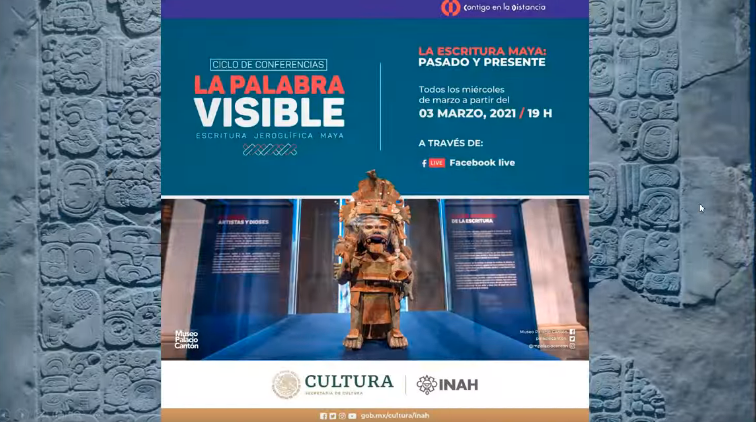
Happy New Year! Today is 11 Ak’bal 1 Pop and we decided to wait until today to post this month’s blog. Spring has arrived, and a new day is dawning, with hope on the horizon that we will finally end this pandemic. I was fortunate to be able to receive my second dose of the vaccine, which became available to educators last month, and it is seeing vastly increasing distribution in the United States, where 148 million people so far have at least received one dose, which is 45% of the population. By comparison, in Mexico, 6 million people have received at least one dose, which is only about 5% of their population. In Belize, about 20,000 people have received one dose, which is also 5% of their population. In Guatemala, some 98,000 people have received one dose, which is only 0.59% or their population. We hope that equitable vaccine distribution will greatly expand in the near future for our friends and family around the world. It cannot come soon enough.
Given the unknown time frame for vaccine distribution, and the current restrictions on public gathering, we do not yet know when it will be safe to continue with face-to-face classes and conferences. Even with increased vaccine distribution, in my own school district, we have already decided to keep our campus closed this fall, due to the inability to know whether our students will be fully vaccinated by that time.
We are adapting to these ongoing circumstances, and there has been a great increase in the availability of online learning using platforms like Zoom. MAM would like to support and encourage the creation and distribution of online learning, which we hope to implement soon. As an example, this month, I would like to call attention to the wonderful presentation given by Archaeologist Memo Kantún for the Museo Palacio Canton in Mérida, Yucatan earlier in March. This was the first online conference of its kind for the Museo Palacio Canton, and it serves as an inspiration for other educators who would like to reach a wide audience by recording presentations like this in Spanish, English, or in various Mayan languages. This was not a conference supported by MAM, but we are very interested in housing presentations like this on our website in the future. Stay tuned for more coming soon!
I hope you all are staying safe, and that we will all be able to finally see one another in the near future. In the meantime, we hope to take advantage of the current technology to continue our important work.
Yum Bo’otik,
Michael Grofe, President
MAM
Haz clic aquí para leer la versión español.
It is hard to believe that it has almost been a year since the pandemic lockdown began for many of us. Since the college where I teach has shifted into an entirely online format, I’ve had the opportunity to explore and share many innovative web-based resources in my classes. In my linguistics class, I have been using several excellent animated videos from NativeLang, a YouTube channel created by linguist and animator Joshua Rudder. I highly recommend the many videos on his channel, and I greatly admire the thought and work he has put into these videos, and how effectively they communicate complex histories and ideas. This month, I would like to highlight one of his videos from last August, in which he explores the revitalization of Mesoamerican scripts, with a particular focus on Maya writing.
Featured in the video is a Tzeltal poem written and published in Maya script by our friend Martín Gómez Ramírez, the famous Stela of Iximché, written in Kaqchikel using an adapted Maya script. Also mentioned is the hieroglyphic version of the K’iche’ Popol Vuh, transcribed by Yan García and designed by Mario Hernández, as well as a discussion of the challenges of converting Maya glyphs into a Unicode text that is readable by computers.
This and other educational online resources have given me the idea that we might explore the commissioning and creation of similar online resources by Maya educators for Maya students. The pandemic continues to force us to consider new ways to continue our work, and given that we may be dealing with the challenges of restrictions on face-to-face classes for the foreseeable future this year, online learning promises to provide new opportunities for educational outreach for those who have the ability to connect to the internet.
Meanwhile, many of us still await our vaccinations, which are still not widely available in the United States, let alone in Guatemala, Mexico, and Belize. May we all stay safe and healthy and get vaccinated soon so that we can once again gather together and see our friends and family to celebrate life and a better future.
Kolaval Tajmek, Matyox,
Michael Grofe, President
MAM